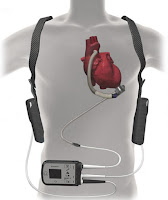The majority of my week was spent in clinic and rounding to
see VAD patients who were recently implanted with a HeartMate 3 as a bridge to
transplant or destination therapy. The image on the left shows a typical HM3
implant where the pump is inserted into the apex of the heart and an outflow
graph is sutured to the aortic arch. Two patients were indicated for
destination therapy (meaning long-term support) as they were ineligible for
full cardiac transplant due to pre-existing conditions. These patients were
recovering well and were expected to be discharged in the near future (~ 1
week).
One patient who received a HM3 on
Monday was in critical condition in the cardiac intensive care unit. This
patient needed to be supported on both the left side and right of the heart to maintain
peripheral perfusion to the rest of the body. The image on the right shows a
heart with mechanical circulatory support on the left sight of the heart (LVAD)
and a Centrimag pump on the right side of the heart (RVAD). The Centrimag is a small extracorporeal pump which
assists supports the right portion of the heart which supplies the lungs.
My
research topic has been narrowed down to identifying indicators that may
predict right heart failure. Although there have been significant strides
recently in the VAD space such as mitigating pump thrombosis and stroke, right
heart failure remains a significant issue and must be addressed in the future. I
will be working with medical students and residents to predict trends in this
space.



How often do you need support on both the right and left sides of the heart? How often do people need right heart support compared to left?
ReplyDeleteIs the recovery from these surgeries similar to an open heart surgery where they do a sternotomy, or is it more intense? Glad you've been able to narrow down a research focus!